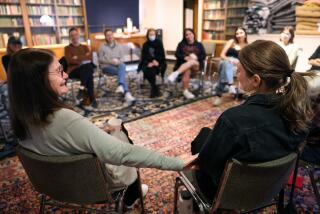‘Death’: New Lease on Life in London : Art: ‘The Art of Death’ exhibition has finally opened at the Victoria and Albert Museum after having been postponed due to the Gulf War.
- Share via
LONDON — Exactly one year ago, Great Britain’s national Victoria and Albert Museum was readying an unusual exhibit called “The Art of Death,” which would show that the English of centuries past were much more willing to confront the subject than their descendants are.
Then, the Gulf War erupted.
Proving their own point in the most ironic way, the museum directors called off the exhibit, declaring that it might be offensive to people at a time when soldiers likely would be coming home in body bags.
With the war now over, the museum has returned to the subject of death. The postponed exhibition has finally opened and does, indeed, reveal how attitudes and behavior concerning death and mourning have changed drastically.
And the underlying message is that the changes have been for the worse--that not only are people today less willing to contemplate and prepare for death, but that society has eliminated many of the rituals that provided comfort for the grieving.
Subtitled “Objects From the English Death Ritual 1500-1800” and continuing through March 22, the exhibition offers objects ranging from the grandiose Will of King Henry VII and the death masks of Oliver Cromwell and George Frederick Handel to more commonplace items such as memorial wrappers on biscuits meant to be eaten at a funeral and a memorial hand-warmer made in 1672. Paintings of death-related scenes abound, with many showing Death--usually in the form of a skeleton coming to collect the living.
“In contemporary Western culture, the death ritual is very low key,” says art historian Nigel Llewellyn, curator of the exhibit. “We don’t dress ourselves differently. We don’t wear black for six months afterwards. We don’t wear artifacts to remember the dead. Our ancestors had a completely different strategy. They confronted their grief with designed objects.”
As an example, he pointed to a 1792 snuff box shaped like a coffin. The object, sitting on a table in someone’s home, was likely to prompt conversation about the dead person it memorialized, says Llewellyn, “which was proper.” Unlike today, discussing the dead with a grieving relative or friend was expected and encouraged.
Another example of using specially designed objects for mourning were memorial rings. Those who could afford it would leave a provision in their will for the manufacture of dozens of rings that would be distributed to their family and closest friends. Numerous examples are on display in the exhibit.
“Our ancestors saw that death was part of the living experience,” says Llewellyn. People surrounded themselves with objects that would help them remember the dead and prepare for their own deaths. These objects “would trigger a tremendous emotional release which had a good effect.”
The attitude today, says Llewellyn, making a sweeping motion with his hands, “is take it away. This system leaves people badly prepared.”
A professor at the University of Sussex, Llewellyn became interested in the “visual culture” of death some years ago and realized there was an entire genre of artwork that had gone largely unnoticed.
Few of the works he has assembled could be classified as “high art.” The objects were created for a far different purpose than aesthetics and longevity.
“A lot of the objects were designed to be buried,” says Llewellyn. “Or they were designed for one performance--at the funeral. Some of it is ephemeral--only meant to last a few days.”
Included in the exhibit is a set of body armor from the early 1600s, which was created specifically to rest atop a coffin during a funeral and was then hung on a church wall.
The materials used for it are “second-rate stuff cobbled together for the occasion,” says Llewellyn. “The whole point is: They didn’t use top-quality stuff. You’re not going to waste your money getting the best materials.”
But somehow these objects have survived, tucked away in old churches or handed down through the generations.
In all, there are more than 250 objects on display, grouped into sections that divide the death process into categories. The first section, “In the Hour of Death,” presents paintings and other works that enabled people to contemplate death. “Between Death and the Grave” includes death masks, coffins, coffin fixtures and burial certificates; “Last Rites” includes paintings of funerals, 17th-Century biers and funeral invitations; “Responses to Grief” and “Objects of Commemoration” present an array of items designed to recall particular people who had died and includes riding gauntlets, rings, gravestones and monuments.
The museum also is planning special events to run in conjunction with the exhibit. These will include demonstrations on the art of making death masks, a session on funeral food, complete with recipes and samples, and performances of “Dances of Death.”
Llewellyn says that, as an art historian, he has not studied why the elaborate death rituals of the past have given way to the big taboo often placed on death today. But he says anthropologists have noted a structural relationship between sex and death that suggests that society allows one of them to be addressed openly while the other is not.
Comparing the role of sex and death in contemporary Britain to the period covered in his exhibit, he says “the two have swapped places.” He also believes it will be noteworthy to see the effects that AIDS--which relates to both sex and death--will have on changing attitudes toward death. Already, he says, there are significant changes in the gay community where people know they are going to die from the disease and funerals are planned well in advance.
More to Read
The biggest entertainment stories
Get our big stories about Hollywood, film, television, music, arts, culture and more right in your inbox as soon as they publish.
You may occasionally receive promotional content from the Los Angeles Times.










